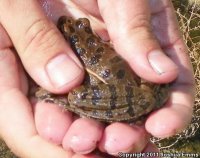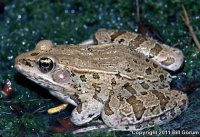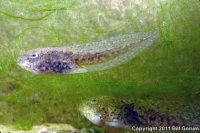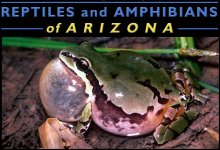| Range: |
 |
| Other Names: |
|
| Description: |
This leopard frog grows to about 4.4 inches in length; males average a smaller size than females. This is a buff, pale brown, or olive green frog with dark spots. It is distinguished from other New Mexico leopard frogs by a combination of characters, including incomplete dorsolateral folds that are broken and inset towards the rear, usually a white spot in the center of the tympanum, a complete lip or supralabial stripe, typically a spot on the snout in front of the eyes, and a reticulation of dark and light on the rear of the thighs that is more open and lighter in color than either the Rio Grande or lowland leopard frog. The tadpoles are relatively pale and uniform in color and may reach >3 inches total length. |
| Similar Species: |
It can be distinguished from the Northern Leopard Frog by its discontinuous dorsolateral folds, the reticulated thigh pattern and halos surrounding the dorsal spots that are absent or very faint. It can be distinguished from the Lowland Leopard Frogby the presence of spots on the nose anterior to the eyes, the presence of a spot on the tympanum and a complete supralabial stripe. |
| Habitat: |
Found in arid environments and can be seen in plains and prairies, along streams, and on the edges of ponds. |
| Behavior: |
Can be found active day or night, although they are easier to find and observe at night with a headlamp or flashlight. Probably moves considerable distances overland and along drainages during summer monsoons, when it can occasionally be found on roads at night. |
| Hibernation: |
|
| Reproduction: |
Plains Leopard Frogs breed from late March through early June, and from August through October. Egg masses contain up to 6,500 eggs and are usually attached to vegetation in shallow water. Tadpoles are known to overwinter. The call is a stuttering chuckle call, similar to the lowland leopard frog. |
| Diet: |
The plains leopard frog feeds upon a variety of invertebrates as well as some vertebrates (a bat was documented in the diet of a Texas specimen). |

















